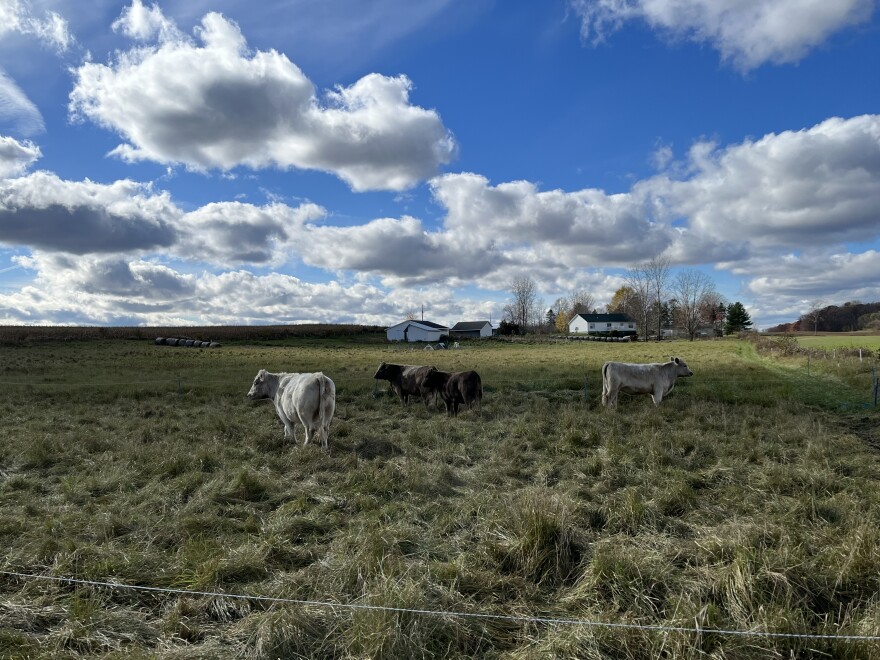Over the past year, interest in sustainable farming practices has been gaining momentum among farmers across the state.
Kable Thurlow, a beef and grazing expert with Michigan State University Extension, said the trend is prompting many livestock producers to switch to rotational grazing, a practice that promises not only healthier livestock, but also sustainable land management.
Unlike continuous grazing, which places livestock in a single pasture unit, rotational grazing moves animals from one unit to another, allowing plants time to regrow.
Rotational grazing has many other benefits such as reducing soil erosion and methane emissions, improving water quality, and preserving wildlife habitats, said Thurlow.
Todd Geurink, a livestock farmer just outside of Mount Pleasant, has practiced rotational grazing for over a decade.
He said he had first learned of the method through reading books on farming practices. He was later able to gain hands-on experience with rotational grazing while he worked at a farm in West Virginia.
Geurink said he also briefly worked at a farm in West Michigan before he moved to his current home in Mount Pleasant.
He now owns Mid Mitten Sustainable Farm LLC where he raises sheep, cows and chickens for food.
He currently utilizes the rotational grazing system with his cow and sheep herds.
According to Geurink, rotational grazing mimics prairies.
“All over the world, wherever you see a prairie, you’ll see these large herbivores and you’ll have the behavior of bunching together in large herds,” Geurink said. “And that’s because that’s how they stay safe from predators.”
Herds will constantly move from one area to another as they run out of grass to eat and become pressured by predators.

“That’s what we do here, except we replace the predators with electric fencing,” he said. “We put the animals exactly where we want them, give them just enough food for however long we want them there, and then move on to the next spot.”
This allows the grazed forage time to regrow to its full potential before it is grazed once again.
Geurink said keeping animals in one space can lead to overeating of their favorite plants, killing them off and in turn decreasing the amount of biodiversity in the pasture.
“Truly what this is, is regenerative. It’s not just maintaining, it’s actually building a more vibrant, more biodiverse ecosystem that produces more year after year after year,” he said.
Rotational grazing focuses heavily on the health of soil. Allowing plants to recover during their resting periods allows for a deeper root system. This system will then fertilize the soil by isolating carbon from the atmosphere.
“One of the things that modern farming has done has really ignored the biology of the soil. They miss the fact that soil is a living ecosystem,” Geurink said.
Thurlow said the deeper root system reduces the amount of bare soil, and in turn reduces erosion and water pollution.
“If we have the soil health, we have increased water filtration,” he said. “That water is going to filter down into the ground into the aquifers like it's supposed to and be used for forage production, as opposed to sitting there and running off and potentially carrying nutrients with it.”
Thurlow said rotational grazing systems are also more cost efficient compared to other grazing methods as it reduces the reliance on hay as a primary source of food for livestock.
According to an article from Michigan State University’s W.K. Kellogg Biological Station, rotational grazing also has the ability to reduce methane emissions from livestock by providing higher forage quality, which is easier for livestock to digest.
Farms that participate in sustainable practices, such as rotational grazing, saw 19% fewer emissions in the first two years of the practice compared to non-participating farms. That number grew to 35% fewer emissions after the first two years.
Thurlow said rotational grazing had become popularized in the state during the 1990s when Ben Bartlett worked as the MSU beef and grazing expert.
Since then, Thurlow said livestock farmers have shown more interest in implementing the system with their own animals.
Despite the increasing popularity and proven benefits, Thurlow said some farmers may be hesitant to adopt the rotational method.
“It does require a little more work than what continuous grazing would, you know, continuous grazing is easy,” he said. “They have to put in more temporary fencing and internal fencing, and they have to figure out how to deliver water to their animals. But there's technology that has made that a whole lot easier.”
He said rotational grazing also requires more thinking on the farmers' part when determining how often to move their animals and predicting how quickly their pasture’s forage will grow back throughout the seasonal weather changes.
Rotational farmers tend to move their cattle more frequently during the spring and summer months and move them less during the colder months.
At this time of year, farms utilizing rotational grazing, such as Geurink’s, are currently preparing their livestock for the winter by adding fewer animals to the pastures, taking longer rotational periods, and allowing the grass to regrow.


